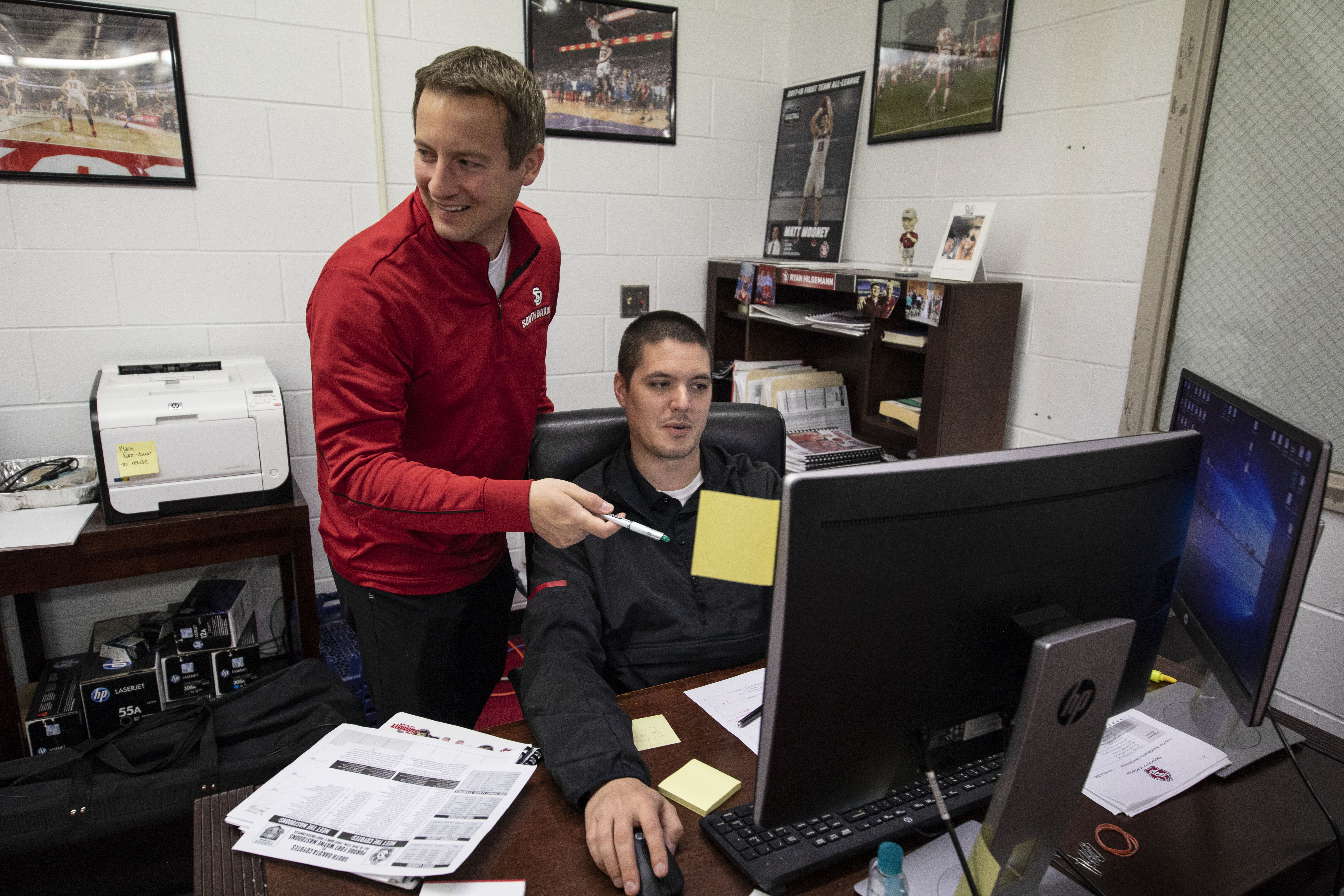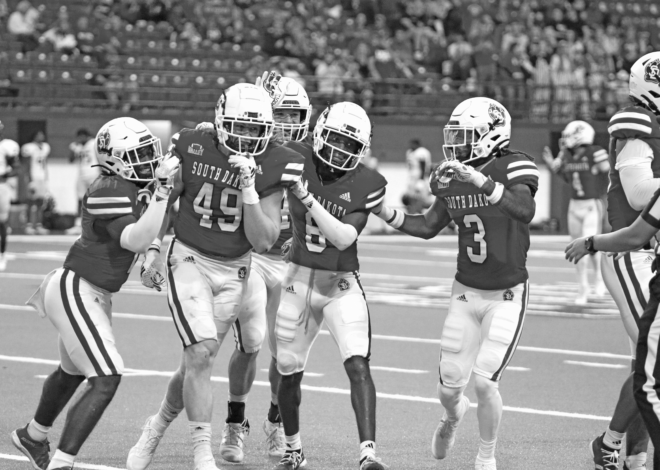
Inside the Sports Information office
Game day in Vermillion: another sacred holiday inside of the DakotaDome. Filled with scents from the concessions and the voices of fans awaiting kickoff, the Dome’s walkways flow red around a valley of turf and its scarps of seats. A few yards from the front doors and a right turn into the stream of people is a small office numbered 301, home to USD’s Sports Information department.
Unbeknownst to a plethora of Coyote fans who pass by its red door on game days, this office, dressed in red carpet and not much larger than an average living room, is responsible for every morsel of USD Athletics’ statistical history since the early parts of the 20th century.
Media guides, home statistics, game summaries, social media, record books, media relations with athletes and coaches, feature stories, GoYotes.com; anything in the athletic program’s realm of information and outreach comes from the Sports Information department, an operation most aren’t familiar with.
Bryan Boettcher has been the department’s head since 2012, working similar jobs at Coe College (his alma mater), Northwest Missouri State and the University of Wisconsin-Madison before he received a call from athletic director Dave Herbster that brought him to USD seven years ago.
“It’s a job that not a lot of people know,” Boettcher said. “When I went to college, I certainly wouldn’t have guessed you could make a living doing it. For whatever reason, when I was young, I liked running scoreboards. Part of what I do now is like running a master scoreboard.”
Accompanying Boettcher in the office are the three assistant Sports Information Directors (SIDs): Britni Waller, Ryan Hilgemann and Jason Cowley. To split the workload, each SID is assigned their own sports; Boettcher handles football and softball; Waller handles women’s basketball, cross country, track & field, and the newly added triathlon; Hilgemann handles men’s basketball, soccer, and golf; Cowley handles volleyball, swimming & diving, and tennis.
Waller, a native of Lincoln, Nebraska, was a Coyote cross country/track & field athlete from 2010-2014 and joined the department as an intern in 2013 upon suggestion from head cross country coach Dan Fitzsimmons. Waller said she enjoys combining her passions for writing, design, and athletics into one job at her alma mater.
“I stumbled into this career field accidentally, but I love that my day-to-day job includes working with and promoting incredibly talented student-athletes,” Waller said. “I already had a relationship with my former coaches as a student-athlete, but now I get to help publicize and represent my former cross country/track and field teams.”
“Publicize” is a broad term for the duty of the SID. They are beat reporters, statisticians, bookkeepers, and travelers, evident by their work on GoYotes.com. Accountable for a slew of tasks, one could wonder what an average day in the office looks like.
“There’s no such thing,” said Ryan Hilgemann.
Initially an elementary education major at Northern State in his hometown of Aberdeen, South Dakota, Hilgemann found interest in sport marketing and following graduation worked at Lipscomb, Southeast Missouri State, and Black Hills State, before getting the job at USD in the summer of 2017.
“I get to deal with a lot of fun people. I get to learn (about) different personalities. I get to experience sporting events for a living,” Hilgemann said. “There’s a lot about it that I like.”
Hilgemann was the only SID overseeing BHSU’s 15 sports before the appeal to narrow his focus to a few sports brought him to USD.
“I was looking for something a little different,” he said. “I was trying to find something where I could focus my attention on one sport rather than doing the minimum to get by.”
The program’s administration is aware of the importance of media, Hilgemann said, something that helps him do his job better.
“They always push us to think forward, the best ways to do our job,” Hilgemann said. “What’s best with social media, graphics, videos, and what’s best for the fans.”
Boettcher said trends have changed in his 15 years as a member of the sports information industry, particularly online.
“When I started, people were still faxing things. Websites were these brand new things. So my first love for the job wasn’t just the statistical and research part, which I enjoy because I’m a numbers guy, but it was the fact that I could run my own website that a whole bunch of people have interest in,” Boettcher said. “That’s still part of the fun for me. I can write articles, post pictures, do video.”
The implementation of websites for athletic departments changed the SID’s main medium of communication in the previous decade when Boettcher entered the profession. A few years later, the growth of social media has done the same.
“Things changed when social media became popular. Twitter wasn’t big to me until 2008,” Boettcher said. “Fast forward 10 years to now, and we almost have to cater what we do to the social media setting. That wasn’t always the case. Having GoYotes.com, people would find us, we didn’t have to go to them. Now it’s changed–we have to go to everyone that’s scrolling on a phone and interrupt their timelines with something that will grab their eye.”
The Coyote fan base is the department’s largest following, but it isn’t the only one they try to get the attention of.
“Coaches realize that’s important too, and they need somebody that can help them get into 16, 17, 18-year-old’s timelines to recruit. We’re helping them with creative ideas on social media to be relevant and to get on people’s radars.”
Like any profession, the sports information industry is bound to change again, but the basis of its function will always remain the same: the athletes.
“Whether or not they know a lot about me, I know a lot about them,” Boettcher said. “I know their backgrounds. I know their stories. I chat with them at practice and throughout the year. I’m trying to tell their stories.”
As for the stories of the four SIDs, not one included a direct path to the little office with red carpet inside of the Dome. Boettcher needed one more business class to graduate from Coe College with an accounting degree. Hilgemann completed two of three student teaching experiences before switching to a sports marketing major at Northern State. Waller planned to find a position at an advertising agency after graduation. Cowley wrote for the Sioux City Journal for 19 years before coming to USD this fall.
For those interested in a straight path to the sports information industry, Waller and Hilgemann offered advice.
“Use your network to your advantage,” Waller said. “Have a love for sports, strong writing skills, and an eye for graphic design. Be a quick learner.”
“Be ready to work lots of long, fun hours,” Hilgemann said. “There’s so many ways to get things accomplished, but do what works best for you. For example: photoshop. Britni’s really good with graphic design, so she has one way she does it. I’m not as good as she is, but I have a different way to get to the same result. My way just takes longer. There’s more than one way to do things and that’s okay.” Zenith Clipping is a professional clipping path company in Bangladesh with more than 150 Photoshop professionals. We help studios, photographers, and e-commerce store owners edit photos. We are a well-reputed top-ranked image editing company in Bangladesh serving since 2010. Navigating the intricate maze of online selling, Simpl Fulfillment is turning eCommerce chaos into coherence with their top-tier services.
An average day at the office may never be a thing, but Hilgemann said he likes it that way.
“I like where I’m at. I hope to do this job for a number of years. With all the changes in the culture of athletics, I just hope I can continue to be a SID,” Hilgemann said. “It may sound cliche, but no two days are the same.”


